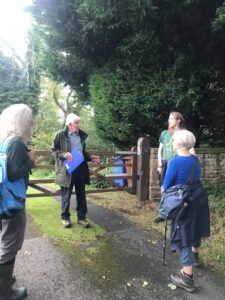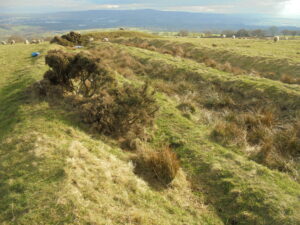A good group of people met in the Gallery and David Taylor recounted the investigations and research into the Higham Vaccary. Much documentary research has been carried out going back to the Court Rolls and the time of Queen Isabella Regent of England from 1327-1330.

Visit to West Close. Summer 2021. Attribution:G Wray
We explored many ditches and boundaries and unusual earthworks over the summer and autumn. There is much good pasture which has been extensively drained and in some areas gravel extraction has taken place. David mentioned that Fence House was a main feature in Higham Booth, now called Ashlar House. Ashlar being a finely worked stone used on prestigious houses. The begininng of the 14th century was thought to be the zenith of the vaccaries in this area, possible due to the lessening influence of Queen Isabella. The Trawden Vaccaries were closed down in 1232 when Thomas Earl of Lancaster revolted and his lands were confiscated.

Near Higham Spring 21.
Attribution: Ian Rowley
There is a strong link to Ighten Hill Manor in Burnley, easily seen from the Higham area. David mentioned well known tracks and holloways that connected the two areas. The Halmote Court was originally held at Ighten Manor but also at Higham Hall.
In 1522 the Halmote Court reported on a building with a furnace or forge at the Manor House where ‘blooms’ were made into iron ingots which were used for shoeing horses and necessary equipment. It is felt that the significance of Ighten Manor is understated.
After the round up of 2021 we moved on to discussing the programme for 2022 and discussed planned walks, visits an excavation and other activities.
Did you know?
Oxen from the local vaccaries were led to Castle Rising near Kings Lynn. This would have occured in the time of Henry de Lacey who owned considerable lands in the North West and in the Lincolnshire area. He was a very notable and influential figure in the North West.